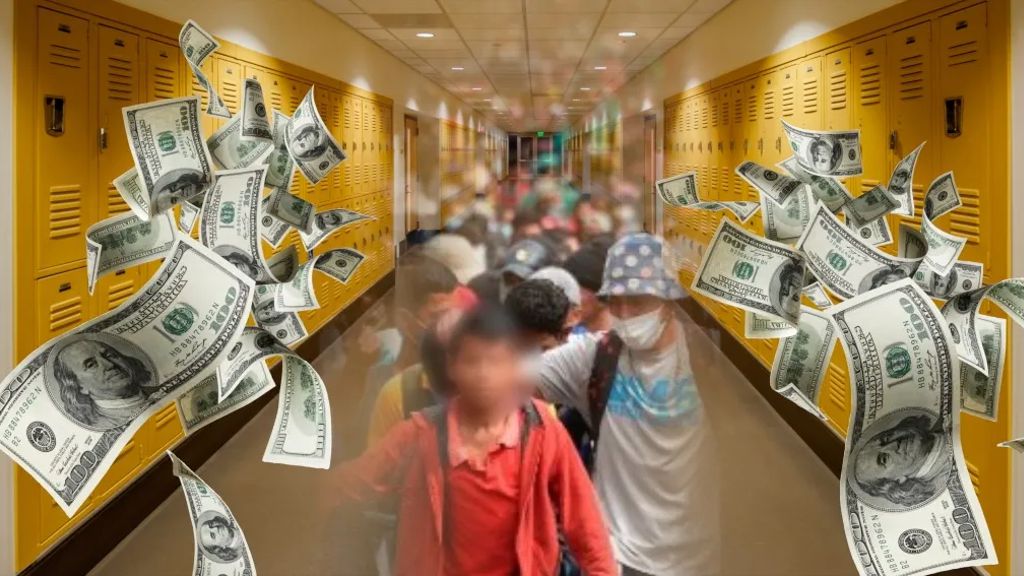Summary of Findings
Public school districts across the United States continue to suffer under a massive unfunded mandate imposed by the federal government: the requirement to educate millions of illegal aliens, the school-age children of illegal aliens, and unassimilated/unvetted refugees, all at taxpayer expense. Further adding to this burden are millions of students from legal immigrant families admitted into this country despite being unable to fluently speak English. FAIR estimates that it currently costs public schools just over $78 billion to serve this burgeoning population based on data from 2020. The struggle to fund programs for students with limited English proficiency (LEP) represents a major drain on school budgets as they redirect resources away from American citizens to support English learner programs for this cohort.
Currently, 5.1 million students – or more than 10 percent of all students in American public schools — are designated as LEP. Despite this, only 370,000 of teachers hold the proper certifications to adequately educate them, according to the U.S. Department of Education. It is estimated that at least 76,000 additional teachers are needed to properly educate this cohort over the next 5 years. Currently, more than 100,000 instructors are acting as LEP teachers despite lacking the proper certification.1
The lack of necessary teachers and infrastructure to educate this population has hindered the performance of LEP and non-LEP students alike and has severely stunted the ability of the children of new immigrants to assimilate into American culture. As a result, the children and grandchildren of immigrants in America today are finding far less educational and economic success than they did in the past.2
Since the most recent cumulative data on this subject comes from 2020, it’s important to keep in mind that, unless otherwise noted, the figures detailed within this report do not take into account the massive surge of legal and illegal immigration into the United States since President Biden took office.
Scope of the Problem
Based in large measure on the 1982 Supreme Court ruling Plyler v. Doe, school districts must fully accommodate the children of illegal aliens as well as the children of lawfully present migrant families. This largely unfunded mandate on states generated an acute need for educators capable of teaching LEP students and has made it difficult and expensive to keep schools properly staffed. Since illegal alien families are virtually all low earners who pay little to no taxes, the cost of educating these students falls almost entirely on the shoulders of American citizens and lawfully present immigrants.3
The federal government only provides 7.9 percent of public school funding.4 The rest comes from state and local resources, split roughly down the middle. For LEP programs, however, Congress contributes barely 1 percent of the cost despite the federal requirement for states to educate the children of illegal aliens.
With new migrants flooding school systems due to unchecked immigration policies in the United States and school budgets not proportionally rising to accommodate this influx, local districts are feeling the squeeze. Furthermore, many of these students not only lack basic English-speaking skills but also come from locations that offered subpar education, if any at all, in all subjects. Because of this, already overwhelmed and underpaid teachers are facing additional strain and student performance is unsurprisingly lagging.
Despite a significant growth in public school enrollment, the decade after the Great Recession saw some of the most catastrophic budget cuts to public school districts in recent history. In 2015, 29 states provided less overall state school funding per student than they did in 2008.5
The general consensus was that between 2016 and 2025, schools would be able to fully recover from these cuts. However, the unexpected COVID-19 pandemic resulted instead in further cuts to the education system. Approximately 570,000 education-related jobs were slashed nationwide during the height of the pandemic, and most school districts have not fully recovered financially or academically.6
Increased immigration places a strain on school resources for three primary reasons: 1) new migrants have not contributed federal, state, and local taxes to the public school system for a significant period of time prior to their children enrolling, and thereby don’t offset the cost of education deficits. 2) According to the U.S. Census Bureau, the poverty rate for new migrant families is more than 60 percent higher than it is for native-born families.7 3) New migrant families often do not speak English well. Even though the average new migrant family does not contribute enough in taxes to cover the cost of their children’s education, their schooling costs significantly more than the education of the average public school pupil.
These might not be significant issues if migrant families went on to earn more than native-born families in the long term, but this is not the case. The overall median income for migrant families is roughly $2,500 less than native-born families, so the initial drain on school resources is not adequately recovered in the long run.8
So, as more and more migrants move to the United States (legally and illegally) and enroll their children in public schools, the strain on school resources is only growing. Additionally, as noted previously, there is already a severe shortage of teachers who are properly qualified to teach LEP students. Because of this, there is little evidence that schools will be able to appropriately handle the additional influx of new students triggered by the multiple immigration crises facing the United States. Considering that public schools typically release full enrollment and performance data 1-2 years after the conclusion of each school year, it could be some time before we know the full adverse impact of the Biden Administration’s failed immigration policies.
Cost To Taxpayers
Nationwide, LEP students cost taxpayers just over $78 billion annually. Virtually the entirety of this cost, 99 percent, is borne by taxpayers at the local and state levels. The cost to educate LEP students has swelled by $18.8 billion since 2016. This massive increase is primarily due to an increase in the total number of LEP students, as well as large increases in associated education costs.
This fiscal impact is felt well beyond states that share a border with Mexico. In fact, 14 of the 17 states spending more than $1 billion on LEP programs in 2020 don’t border Mexico: Colorado, Illinois, Washington, Virginia, Georgia, Massachusetts, Michigan, Minnesota, Florida, New Jersey, North Carolina, Washington, New York and Maryland.
Read Full Research Report on FairUS.org

















































